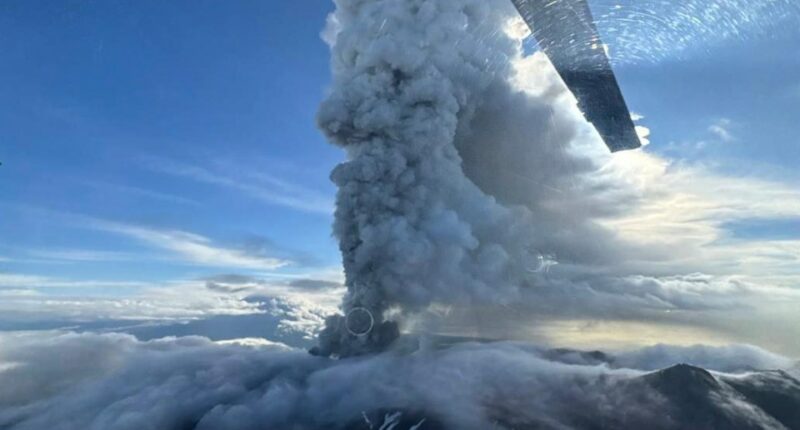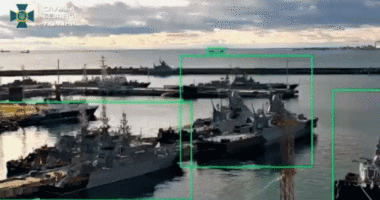Share this @internewscast.com
SCIENTISTS have warned of the growing number of volcanic eruptions along the Pacific “Ring of Fire” triggered by an enormous earthquake.
A chain of three volcanoes has now been set off – with one roaring back to life with its first eruption in 600 years on Sunday evening.
The largest volcano in the area, Klyuchevskaya Sopka, erupted with a flow of hot lava shortly after a massive earthquake struck the Pacific last week.
Then on Sunday, the Krasheninnikov volcano spewed a colossal column of ash nearly 4 miles into the sky in the “historic” eruption.
And the alarm was raised on Monday evening local time over rumbling at a third site, the Mutnovsky volcano.
Authorities have strongly advised people to stay away from the volcano following a “thermal anomaly” detected by the Kamchatka Volcanic Eruption Response Team (KVERT).
The string of geological detonations was ignited by a monster 8.8 magnitude earthquake last Wednesday – the sixth-strongest ever recorded.
Its epicentre was around 84 miles southeast of the Kamchatka Peninsula and triggered tsunami warnings across a wide area around the Pacific.
Fortunately, the feared destructive tsunami did not occur. However, sad videos have surfaced showing whales that were killed by the earthquake washing ashore.
Dr. Alexey Ozerov, Director of the Russian Institute of Volcanic and Seismic Sciences, confirmed a “direct connection” between the strong earthquake and the volcanic eruptions.
The activated volcanoes are part of the “Ring of Fire”, a vast horseshoe-shaped area around the Pacific Ocean home to hundreds of volcanoes.
Dr Ozerov said: “We associate the eruptions with the earthquake, which activated magmatic centres, and ‘pumped’ additional energy into them.”
Scientists explain that the powerful earthquake likely destabilised the earth’s crust and created fractures which magma can push through.
Dr. Jonathan Paul, a volcanologist from Royal Holloway University of London, explained to the Daily Mail that the earthquake released significant stress in the Earth’s crust, which may have facilitated the eruption by creating new weaknesses for magma to rise through.
He said the delay between the initial earthquake and the eruption of Krasheninnikov was likely due to the fact that cracks in the rock take time to develop.
In the interim period, magma would have been forcing itself through new lines of weakness and building up enough pressure to break through, he said.
The succession of eruptions has sparked fears that more are on the way along the Ring of Fire volcanoes – 160 of which are in Kamchatka.
Michael Manga, a geoscientist at the University of California, Berkeley, previously said: “The volcanoes in volcanic arcs, including Chile, the US Cascades, Japan, Indonesia and Kamchatka, are prone to erupt after earthquakes.”
The last time Krasheninnikov erupted was sometime between 1423 and 1503.
KVERT issued an aviation “red alert” warning of significant levels of ash in the air.
As of Monday evening local time, the eruption remained active with the emergency group warning that ash explosions of up to 10 km could occur at any time.
Russian volcanologist Alexei Ozerov said of the Krasheninnikov eruption: “A crack opened up along the volcano from the top of the crater, and a steam-gas mixture is currently rising from this crack.
“Emissions are occurring, and a large amount of ash was ejected during the opening of the crater crack.
“This ash reached the Valley of Geysers, and the smell of gas.
“A question is immediately raised about the evacuation of the Valley of Geysers, those tourists who are there.”
What is the Ring of Fire?
THE Ring of Fire is an enormous horseshoe-shaped band around the Pacific Ocean which experiences extremely elevated tectonic activity.
Around 90 percent of the world’s earthquakes occur within the bounds of the 25,000 mile-long, 300 mile-wide zone.
And somewhere between 750 and 915 volcanoes lie in the zone, depending on which areas are included.
The density of earthquakes and volcanoes along the Ring of Fire is created by the borders of various tectonic plates meeting.
Primarily, it is the Pacific Plate interacting with others – such as the the Eurasian, North American, and Australian plates.
These are constantly moving past, colliding with and sliding beneath one another, creating an immense amount of stress and pressure in the earth’s crust.
The Ring of Fire traces the Pacific coast up from the southern tip of South America, along the coast of North America, across to Asia and down the coasts of Japan, the Philippines and Indonesia before reaching New Zealand.





















